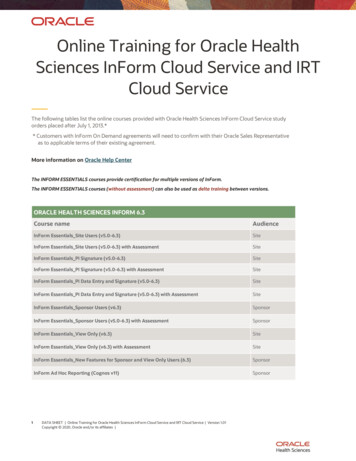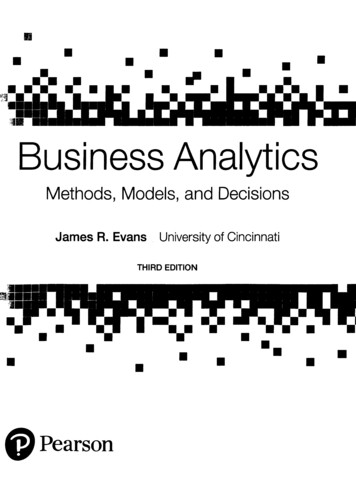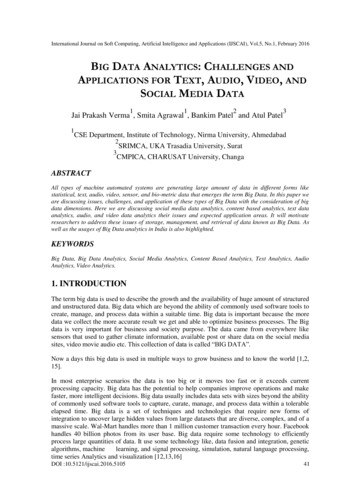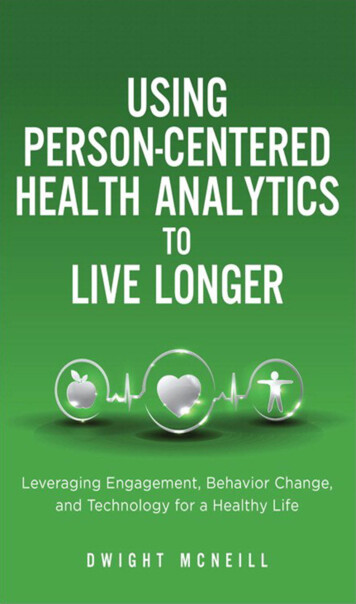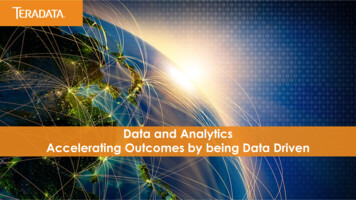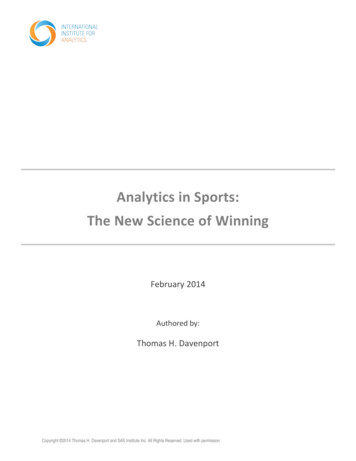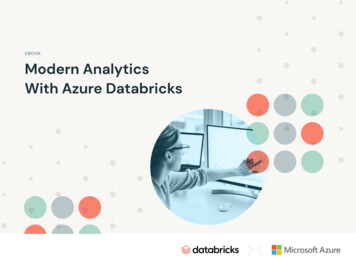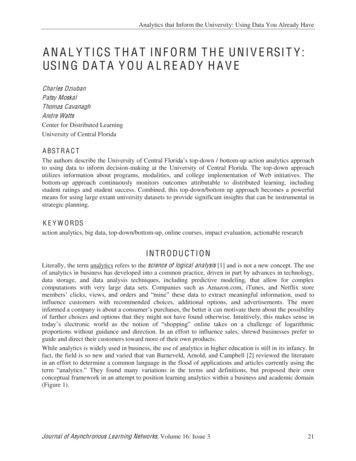
Transcription
Analytics that Inform the University: Using Data You Already HaveA N A L Y T I CS T H A T I N F O R M T H E U N I V E RSI T Y :USI N G D A T A Y O U A L R E A D Y H A V ECharles DziubanPatsy MoskalThomas CavanaghAndre WattsCenter for Distributed LearningUniversity of Central FloridaA BST R A C T " /."),- - ,# ." (#0 ,-#.3 ) (., & &),# :- top-down / bottom-up action analytics approachto using data to inform decision-making at the University of Central Florida. The top-down approachutilizes information about programs, modalities, and college implementation of Web initiatives. Thebottom-up approach continuously monitors outcomes attributable to distributed learning, includingstudent ratings and student success. Combined, this top-down/bottom up approach becomes a powerfulmeans for using large extant university datasets to provide significant insights that can be instrumental instrategic planning.K E Y W O R DSaction analytics, big data, top-down/bottom-up, online courses, impact evaluation, actionable research INTRODUC TIONLiterally, the term analytics refers to the science of logical analysis [1] and is not a new concept. The useof analytics in business has developed into a common practice, driven in part by advances in technology,data storage, and data analysis techniques, including predictive modeling, that allow for complexcomputations with very large data sets. Companies such as Amazon.com, iTunes, and Netflix store' ' ,-: &# %- 0# 1- ( ), ,- ( 8'#( 9 these data to extract meaningful information, used toinfluence customers with recommended choices, additional options, and advertisements. The more#( ),' )'* (3 #- )/. )(-/' ,:- */, " - - ." . , it can motivate them about the possibilityof further choices and options that they might not have found otherwise. Intuitively, this makes sense in.) 3:- & .,)(# 1),& - ." ().#)( ) 8-")**#(!9 )(&#( . % - )( " && (! ) &)! ,#."'# proportions without guidance and direction. In an effort to influence sales, shrewd businesses prefer toguide and direct their customers toward more of their own products.While analytics is widely used in business, the use of analytics in higher education is still in its infancy. Infact, the field is so new and varied that van Barneveld, Arnold, and Campbell [2] reviewed the literaturein an effort to determine a common language in the flood of applications and articles currently using the. ,' 8 ( &3.# - 9 " 3 )/(d many variations in the terms and definitions, but proposed their ownconceptual framework in an attempt to position learning analytics within a business and academic domain(Figure 1).Journal of Asynchronous Learning Networks, Volume 16: Issue 321
Analytics that Inform the University: Using Data You Already HaveAnalyticsBusiness AnalyticsAcademic AnalyticsLearning AnalyticsPredictive AnalyticsActionable Intelligence (Action Analytics)Decision-MakingF igure 1. Conceptual F ramewor k of A nalyticsSiemens et al [3] differentiate between learning analytics7which focuses on data related to learnersprimarily to improve student success7and academic analytics7which is aimed at improvingorganizational effectiveness through learner, academic, and institutional data. They propose an integratedlearning analytics platform that provides an open infrastructure for researchers, educators, and learners todevelop new technologies and methods.Many of the current applications of analytics in higher education are focused on Learning Analytics orAcademic Analytics. The emphasis is on using very large data sets to inform faculty, students, andadministrators when students are at risk and, in some cases, suggest possibilities for improving theirperformance within a course. Approaches vary widely both in terms of data used to develop models andapplication of data to inform students, faculty, and the institution. However, a number of researchers haveidentified models and/or applications that have shown promise on their campuses.One of the most familiar systems was developed by Campbell [4] and his colleagues at Purdue. They havehad success with their use of analytics in identifying students at risk and employing alerts to make themaware of the status within a course, utilizing student information, learning management system data, andstudent grades to form a model of course success. Signals notifies students using a traffic light to identifyif they are doing well (green light), in danger (yellow light), or at risk (red light) for failing in a course.Campbell found, however, that identifying a student as at risk was not sufficient because those studentswho need the most help also are those that ignore the signals and do not take advantage of resources thatmight help them improve. Recently, the Signals application was acquired by Sungard and is now beingmarketed to campuses as a means to potentially help improve student course success.University of Maryland, Baltimore County (UMBC) [5] found that students who have a grade of D or Fused the course management system on average 39% less than higher performing students. Fritz [5] and"#- )&& !/ - , . 8 " % 3 .#0#.39 .))& .) &&)1 -./ (.- .) ')(#.), ." #, *,)!, -- #( Blackboard compared to their classmates. Initially, few students used the system, but when the campusdeveloped a marketing campaign to advertise CMA and made sure the tool was easier for students to bothfind and use, students did increase their usage ( #.#)( -./ (.-: " 0#), 1#." ." )/,- management system also changed and they became more active participants in interacting with coursematerials through the system.)& -. #( ( .4:- [6] survey on the use of analytics in higher education resulted in a framework offive stages: data extraction, performance analysis, what-if decision support, predictive modeling, andautomatic process triggers (such as alerts). Further, they found that three factors contributed to aninstitution:s successful use of analytics: effective institutional training, staff skilled in understanding andapplying analytics, and leaders committed to evidence-based decision-making. They found mostuniversities using analytics for admission prospects or to identify at-risk students.Campbell and Oblinger [7] suggested considering analytics as an engine that guides the decision makingprocess in five steps: capture (data), report (trends), predict (with a model), act (intervene), and refine (themodel and process). Also, they stressed the importance of organizational readiness in terms of thesupport required to successfully implement learning analytics into the culture of the institution. Thepossibility of using analytics to oversimplify what is a complex system of student variables that create asuccessful course, program, or degree experience is a concern with this approach, which further typifies22Journal of Asynchronous Learning Networks, Volume 16: Issue 3
Analytics that Inform the University: Using Data You Already Havewhy clear goals, objectives, and support are critical [8].Much has been written about the potential of learning analytics at the course level [5, 9, 10]. Certainly,there is demonstrable value in being able to identify 8at risk9 students and proactively intervene to getthem back on track. Likewise, mining through the usage of instructional tools to understand effectivetechnology-based teaching strategies can yield important trends that can inform future coursedevelopment. However, the same potential exists to leverage data analytics strategically at theinstitutional level. Being able to examine macro data across departments, colleges, and the largeruniversity can reveal institutional opportunities that might have otherwise remained hidden.A N A L Y T I CS A T U C FAt the University of Central Florida (UCF), the Center for Distributed Learning (CDL) is responsible foroverseeing this institutional lookout of what is a combination of what van Barneveld, Arnold, andCampbell [2] " 0 && 8 /-#( -- ( &3.# -9 ( 8 .#)( ( &3.# - 9 ) ) ."#- 1 ' #(. #( -#'/&. ( )/- 8.)*- )1(9 ( 8 ).)'-/*9 0# 1- ) 1" . #- " ** (#(! ,)-- ." /(#0 ,-#.3 , & . .) distributed learning (completely online, blended, and lecture-capture courses and programs).T O P-D O W N P E RSP E C T I V EFrom a top-down perspective, CDL has developed a proprietary data mining platform called theExecutive Information System (EIS). The EIS (Figure 2) began as a skunkworks project to better /.)' . :- #&#.3 .) (swer various questions from senior administration. Over time it has growninto an indispensable tool in the management of a high-growth online learning initiative at the secondlargest university in the nation. Among the diverse set of functions the EIS offers are: manages faculty development scheduling and credentialing to teach online. maintains historical faculty teaching records across all modalities, as well as master courseschedule data. tracks productivity data (e.g., registrations, sections, student credit hours, etc.) by campus,college, and modality. permits program tracking for regional accreditation and state governing board reporting. monitors student demographics.F igure 2. Home Page of the E xecutive Infor mation System (E IS)Journal of Asynchronous Learning Networks, Volume 16: Issue 323
Analytics that Inform the University: Using Data You Already HaveA. How the E IS Wor ksThe EIS is a classic web based application that utilizes a relational database as its primary data source. Itis a split system where the web server sits separate from the database server as opposed to both being onthe same computing environment. This allows for increased system performance and scalability overtime. At just a little over 500MB, the amount of data within the database is actually small whencompared to reporting data systems of similar characteristics. Unlike larger data warehouses that coverthe whole organization, the EIS is a much more focused and tailored solution. The smaller focus allowsfor easier adaptability, development and maintenance over time as needs and request patterns change. Italso allows for lower server and storage costs as the database does not consume vast quantities of spaceand the overall system does not suffer from performance degradation.The EIS is mainly driven by open source applications. The three main open source applications thatpower the core functionality of the EIS are: MySQL 6 Popular and widely used open source relational database system; PHP 6 Widely available scripting language primarily used for web development; Apache HTTP Server 6 Widely used HTTP server.All of these applications have proven to be highly reliable and scalable for this particular application.Regardless of applications or technologies that power a system such as this, it is its internal architecturethat becomes critical to its success.The internal architecture of the EIS centers around four main processes: data input, data preparation, datastorage, and data display. Figure 3 below outlines the overall architecture of the EIS including someexamples of what is contained in each process outlined above. The system in general does not deviatefrom the spirit of the traditional extract, transform, and load (ETL) methodology present in modern datawarehousing applications. As with most ETL processes, those of the EIS are highly specific to how thesystem stores and ultimately reports on the data.F igure 3. E IS A rchitecture24Journal of Asynchronous Learning Networks, Volume 16: Issue 3
Analytics that Inform the University: Using Data You Already Have " *,#' ,3 . -)/, ." . - ." )' - ,)' :- Enterprise Resource Planning (ERP)system, PeopleSoft. These data consist primarily of class schedule data, LMS data, and studentperformance and demographic information. The ERP data is extracted, prepared, and enteredautomatically into the EIS database on a nightly basis. Once in, the class schedule data becomes the heartof the system as most all other data points are directly related to this information. The secondary sourcesof data come from primarily manual entry. These data consist of faculty development information andacademic program data from the university graduate and undergraduate catalogs.While most of the data in the EIS are inter-related, some numerical population data like headcounts are & /& . /,#(! ." #(*/. *,) -- ( -.), - 8 .9 . & " *,#' ,3 */,*)- ) ." - . . lesis to save system processing time and improve the user experience on the web interface. It would be quiteexpensive in terms of data processing time to both the system and the user if information that was basedoff these fact tables had to be derived ad-hoc as opposed to simply being retrieved. This delicate balanceof how data is derived is critical to the overall system and its efficacy as a reporting mechanism to highlevel constituents. Special care is taken to ensure that all generated reports are finished and presented tousers in an acceptable time frame.The analytic reports that the EIS generates all fit into the high level report categories that are shown inFigure 3. The specific outputs and reports within these categories directly support the processes alsodefined in the graphic. Most reports and statistics are generated within the EIS upon request anddisplayed to users via the web interface. Data can also be retrieved via Structured Query Language (SQL)by users with the access and know how to do so. The web interface is broken up into categories (Figure2) covering faculty development, class scheduling, academic program planning, and statistics. For morevisual users, a dashboard is available that turns the numerically heavy statistics into charts and graphs.Approximately ninety percent of data retrieval comes from utilizing the web interface and its pre-definedreports.B. Putting A nalytics into ActionWhile the EIS is a powerful suite of features, it is constantly evolving, adding reports, creating a newquestion for every question it answers. Perhaps its most powerful aspect is the fact that a majority of thedata that it analyzes and reports on exist in various other locations throughout the university (such asInstitutional Research). However, the EIS aggregates these existing data with some manually-entered datato create a robust architecture that allows UCF to maintain a top-down view of what is happening withtechnology-based learning at all levels across the entire institution.This ability to leverage existing data from elsewhere in the university and analyze the aggregate data setfor various purposes is extremely valuable. For example, CDL uses the EIS to continually monitor eachprogram in the university catalogue to determine how close it is to being offered 100% online. Throughthis process it was discovered that two tracks of a social science major were already 100% online, yetthey were not declared as such for the official online program guide.However, in subsequent discussions with the department chair, it was learned that due to a facultyscheduling issue he was unable to declare the degree completely online. He could not guarantee that oneparticular required course would always be offered in that modality. He sim*&3 # (:. " 0 ." /&.3 .) )''#. .) -/**),.#(! ." !, - /&&3 )(&#( ) ,#(! & ,-"#* ." ( **,) " :- Regional Campus administration to inquire if they would be interested in securing a new faculty line onbehalf of the department. Regional Campus has the ability to hire faculty for departments and place themin one of ten teaching sites around central Florida.Regional Campuses was interested in adding the degree program to its offerings (online learning is asignificant component of the Regional Campus strategy). They agreed to hire a new faculty member forthe department on the condition that he/she would be committed to teaching the required course online,thus allowing the degree to be offered completely online. Declaring a degree as 100% online opens upadditional opportunities for program outreach and growth. The final result was that CDL was able to list anew online degree program, Regional Campuses was able to offer a new program to Regional students,Journal of Asynchronous Learning Networks, Volume 16: Issue 325
Analytics that Inform the University: Using Data You Already Haveboth online and face-to-face, and the department gained a new faculty member and the additional reach ofan online program. It was the proverbial win-win-win and it was all facilitated by the data that wererevealed within the EIS.It is important to note that having the data is only half the equation. In order for those data to be valuable,the institution must do something with them. In the example above, the data were used to open a dialoguewith the academic department and Regional Campuses that resulted in a new online degree program beingoffered. While each situation is unique, this is a fairly representative example of how UCF is bothanalyzing data and taking action based on it from a top-down, institutional viewpoint.B O T T O M-UP P E RSP E C T I V EFrom a bottom-/* *)#(. ) 0# 1 :- - , " (#.# .#0 ), "#(! .#0 ( -- maintainsa robust program of continual analysis and interpretation of data points such as student success,withdrawal, and perception of instruction (end of course evaluations). If the EIS top-down data are used.) - ( ." /(#0 ,-#.3:- #-.,# /. & ,(#(! #(#.# .#0 ,)' *,#' ,#&3 / (.#. .#0 -. ( *)#(. ." bottom-up data are used to identify trends, compare performance, and track the progress of distributedlearning.These bottom-up student performance and perception data also help to inform decision-making at alllevels of the university. New inquiries by RITE researchers have focused recently on grade point average(GPA) as a more reliable predictor of student success than other typical variables that are often studied inthe context of learning analytics.A bottom-up approach to analytics using preexisting data capitalizes on the institutional culture byproviding faculty members and learning support personnel with information about the likelihood thatstudents may not succeed in their courses. The process does not require additional analysis platforms thatuse student interactive data for a course and, therefore, does not assign specific nonsuccess probabilitiesto individual students. However, inherent in his approach to analytics is the capability of identifyingrobust risk probabilities across all instructional modalities (not being tied to any one mode or learningmanagement system), student levels, demographic categories, colleges, and disciplines. The advantage ofthis method is its widespread applicability. The disadvantage is that these data are somewhat less specificabout individual students. As a result, institutions will have to make decisions about the opportunity costsinvolved in any analytic data collection processes verses the added value achieved for collecting andusing such information. However, the objective of the bottom-up institutional approach has the sameobjective as any other analytics approach: support our ability to maximize the chances of student successin courses and ultimately, help them receive their degrees. After all, analytic models, and there seem to agoodly number these days, should converge on student-success.A. Necessary Preexisting ConditionsData are much more useful when they play out against an understanding of the institutional context froma system such as the one described in the top-down sections of this article. Effective analytics procedurecannot function effectively in isolation from the institutional climate. Figure 4 portrays our thinking aboutthe intersection of several domains in an effective analytics paradigm.F igure 4: Integrated Domains for A nalytics26Journal of Asynchronous Learning Networks, Volume 16: Issue 3
Analytics that Inform the University: Using Data You Already HaveGardner Campbell called these 8integrated domains9 [12]. If students are engaged in the learning processand somewhat at-risk, altering them to that fact may, in all likelihood, motivate them. However, in ourresearch on reactive behavior patterns [13], we have come to understand that sending an increased riskmessage to several student types can have just the opposite of that intended effect. Understanding theseinteractions, developing strategies for dealing with them, and sending the most appropriate message arecritical to maximizing the success possibilities. The same holds true for faculty engagement levels.Engaged faculty are much more likely to use analytics for helping students achieve success, in somecases, by additional personal intervention when possible. Equally important in an effective analyticsprogram is how useful data are to all concerned constituencies, not just students. Faculty andadministrators are equally important to the process. The final component of Figure 4 makes the case thatcontinued student and faculty support are critical to the success of any analytics initiatives. Hartman,Moskal, and Dziuban [13], in describing the necessary elements for operationalizing blended learningprograms, have framed elements that apply just as well to an effective analytics initiative:1. Effective institutional goals and objectives2. Proper alignment3. Organizational capacity4. A workable vocabulary5. Faculty development and course development (we substitute analytics) support6. Support for students and faculty7. Robust and reliable infrastructure8. Institutional level on effectiveness9. Proactive policy development and10. An effective funding modelThe bottom-up results we are about to demonstrate enjoy a much greater chance of success if these tenelements are in place. Let us be clear about what we mean here. Data do not make decisions, people do.Algorithms may seem like they make decisions but they have to be programmed on how to do so. Therehave been some effective efforts at machine learning but the human interface in the educational analyticsculture is vital to its ultimate success.B. A n E xample of How Judgment Plays V ital to the A nalytics ProcessIn making the case for why decision making enriches the potential of analytics, we circle back to an early0 &)*' (. #( )(&#( & ,(#(! 8 " ) #!(# # (. # , ( " ()' ()(9 [14] made the case thatclass modality, specifically comparing online and face-to-face courses, led most people to conclude thatthere were no effects attributable to course format. One set of studies pursued this question, tallying the(/' , ) 8-#!(# # (. #( #(!-9 [14] while another group conducted meta-analyses based on effect sizes[15]. However Walster and Cleary [16] provided a thoughtful perspective on data analysis when theysuggested that statistical significance is best used as the basis for decision making and not as an absolutedeterminant. They point out that hypothesis testing answers the following question: what are the chancesthat I will get my sample results when the null hypothesis is true in the population? These significant testsare a function of three things:1. Significance level (e.g., .05, .01),2. Sample size, and3. Some effect size or degree of non-nullity as a mean difference. Usually, in the statistical&#. , ./, ."#- # , ( #- -#!(# # - &. 5 Historically, the way most researchers conduct experimental and comparison group studies is toarbitrarily pick a significance level, get the largest sample size they can obtain and run the study. Theconsequence of conducting studies in this way is that by arbitrarily picking a significance level andsample size, the difference that will be significant is pre-determined. The consequence of such anapproach is presented in Table 1.Journal of Asynchronous Learning Networks, Volume 16: Issue 327
Analytics that Inform the University: Using Data You Already Have300x 1 100x 2 101ES .06.41x 1 100x 2 103ES .20.01x 1 100x 2 105ES .33.00x 1 100x 2 120ES 10.00Sample SizeT able 1. Probabilities for Various E ffect and Sample Sizes (SD 15)Table 1 presents 11 sample sizes ranging from 50 to 300 with the mean differences and effect sizesranging from trivial to quite large by most standards. With an effect size of .06 (mean difference 1), onewill never achieve significance with any of the sample sizes while with an effect size of 1.33 (meandifference 20), that will always be significant. The middle two columns of the table demonstrate theimpact of sample size on the significant difference decisions. For effect size .33 (mean difference 5),significance at the .05 level is achieved with a sample size of 75 and greater but not with sample size of50. Finally, the effect size of .20 (mean difference 3), one must have sample sizes in the 200s in order toreach significance levels of .05 or greater. Table 2 provides a further demonstration of how sample sizecan impact your decision about whether a difference is significant or not. That table shows that no matterhow trivial the difference is, if the sample size is large enough, it will lead to significance.x 1 100x 2 101Sample SizeES 0.101000.14750.20500.29Journal of Asynchronous Learning Networks, Volume 16: Issue 3
Analytics that Inform the University: Using Data You Already HaveT able 2. Probabilities for Various Sample Sizes (SD 15)The point is that the analysis is much more effective if some thought and decision making go into theprocess prior to collecting and running any data. Figure 5 provides an example. If the researcher canspe # 3 51, a difference that is of no interest or will not make a practical difference in his or her judgment,then the lower bound for the process has been established. Similarly, # (.# # .#)( ) 52, a difference thatwill make a practical difference, finds the hypothesis testing procedure taking on a completely differentperspective. This involves three steps:1. Identify 51 first 6this is not important to me2. Identify 52 6this is important to me3. Pick a significance level you can live with 6.05, .01 or something else4. Pick a sample size that 1#&& . " 52 /. (). 51. (Reference the program)The result will be a power curve for your study that has the form of Figure 5: very little power *,) #&#.3 ) , .#(! ! #(-. 51 ( !)) & ) *)1 , ! #(-. 52.F igure 5. Ideal Power C urveThis process requires the investigator to provide input into the process and protects him or her fromcalling a trivial difference significant and provides the best opportunity for finding a difference that willbe important. However, this decision making process cannot be accomplished by collecting data andautomatically running it through an analysis program. Waiting for the program to tell you whether or notyour results are significant does not optimize the potential information in your data. Most analyticprocedures do not involve hypothesis but the principles of this demonstration apply. We still need toprovide careful reflection on the process and take full responsibility for our decisions.C. Institutional-level Analytic Data T hat Can A id in Decision M akingOne way that learning technologies impact higher education is by spawning multiple modalities forinstruction. Of course, the index case for these new formats is fully online learning with an underpinningin course management systems. That configuration for teaching and learning enables many of theinteractive analytic platforms described in this paper. At the same time, however, other instructionalmodalities have arisen7blended and lecture capture, for instance. In many colleges and universities,these two modes combined with online and face-to-face instruction provide the bulk of instructionalmodalities available to students. This is the case at UCF. At the institutional level, common analyticsquestions arise about the relative effectiveness of these course modalities in university organizations suchas the faculty senate, student government, the faculty center for teaching and learning, administrativecouncils, colleges and departments among others. Most often these effectiveness questions framethemselves in terms of student success, withdrawal and satisfaction. At the institutional level, providingcomprehensive answers to these questions in a timely fashion contributes to building a university culturethat embraces analytic thinking. Table 3 provides an example of course modality impact for successJournal of Asynchronous Learning Networks, Volume 16: Issue 329
Analytics that Inform the University: Using Data You Already Haveencountered by students in face-to-face, online, blended and lecture capture ,316150,834665,20912,050Fall 0991878787Spring 1091888883T able 3. Summer 1091888886Fall 1090888784Spring 1190888784Summer 1194899179 / -- #( ."#- - #- #( 3 -./ (. ) . #(#(! !, ) 8 9 or better because that level ofachievement enables timely progression toward program completion. The table shows that, on average,highest student success levels occur in blended courses with a range from 90%-94%. Lowest success ratesare found in lecture capture courses ranging from 79% to 84%. At UCF these data serve as the beginningpoint for understanding impact on students realizing that only in very rare cases is the modality of acourse the primary reason for success. These data open a comprehensive discussion about how thesefindings can be explained around issues such as which colleges prefer which modalities, what disciplinesare offered in each of the modalities,
The EIS is mainly driven by open source applications. The three main open source applications that power the core functionality of the EIS are: MySQL 6 Popular and widely used open source relational database system; PHP 6 Widely available scripting language primarily used for web development; Apache HTTP Server 6 Widely used HTTP server.


